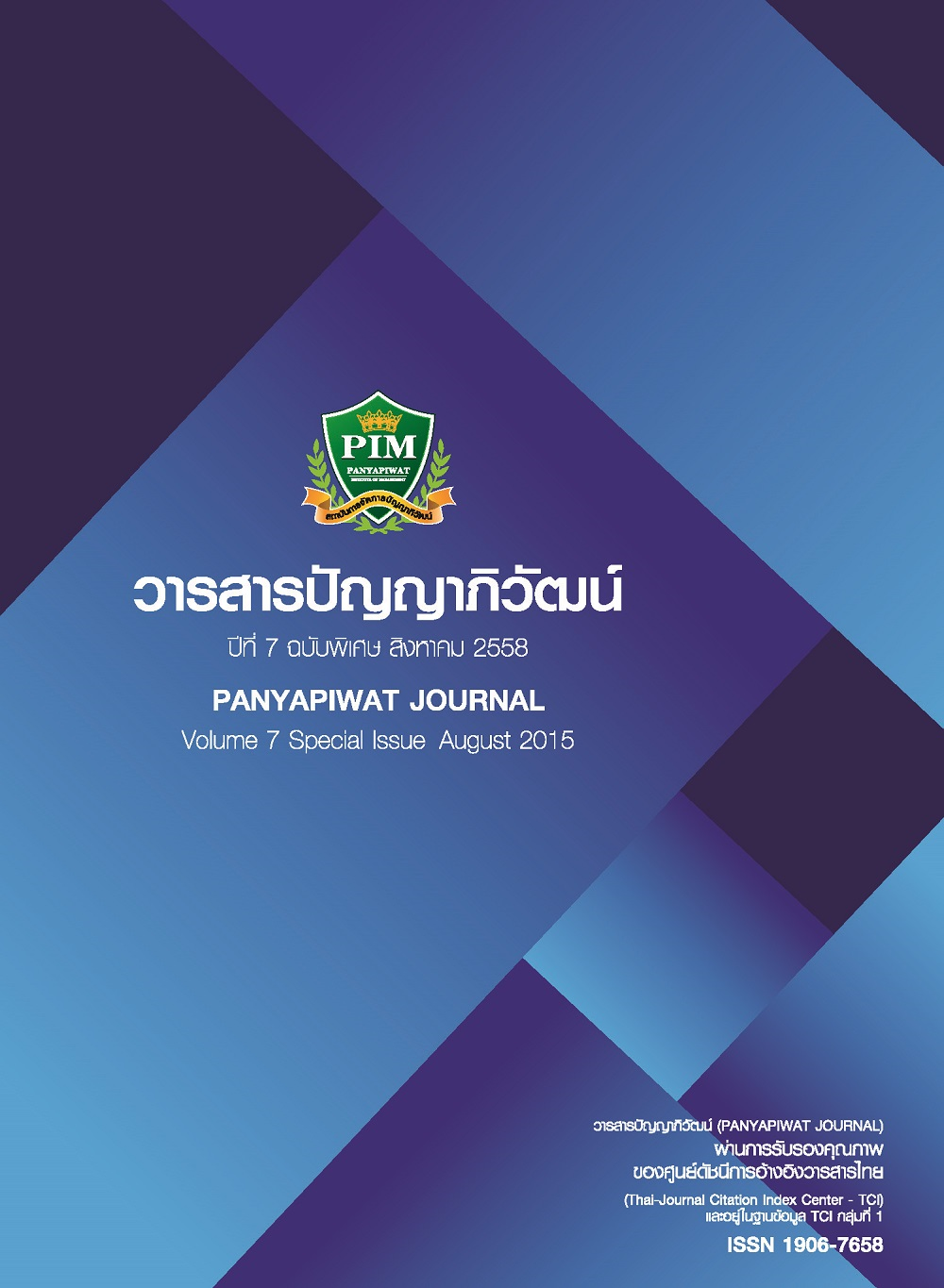แนวคิดเศรษฐกิจพอเพียงจากหนังตะลุงสู่การปฏิบัติใช้ในชีวิตประจำวัน ของนายหนังและผู้ชม
Main Article Content
บทคัดย่อ
การวิจัยเชิงคุณภาพครั้งนี้มีวัตถุประสงค์ เพื่อศึกษาการนำแนวคิดเศรษฐกิจพอเพียงจากหนังตะลุงและการนำแนวคิดเศรษฐกิจพอเพียงไปปฏิบัติใช้ในชีวิตประจำวันของนายหนังตะลุงและผู้รับชมหนังตะลุง เป็นการวิจัยเชิงคุณภาพ กลุ่มผู้ให้ข้อมูลหลักมีจำนวน 30 คน ประกอบด้วยนายหนังตะลุงที่เข้ามาทำการแสดงในพื้นที่ จำนวน 10 คน และผู้รับชมหนังตะลุงในพื้นที่จำนวน 20 คน เก็บรวบรวมข้อมูลโดยใช้แบบสัมภาษณ์ ดำเนินการศึกษาโดยใช้วิธีการสัมภาษณ์เชิงลึกแบบมีส่วนร่วมและเสนอผลการวิจัยด้วยวิธีพรรณนา
ผลการวิจัย พบว่านายหนังตะลุงได้นำแนวคิดเศรษฐกิจพอเพียงสู่ผู้รับชมโดยผ่านตัวตลกและตัวพระตัวนางของหนังตะลุง และนายหนังตะลุงจำนวน 10 คน ได้นำแนวคิดเศรษฐกิจพอเพียงสู่การปฏิบัติในชีวิตประจำวันด้านภูมิคุ้มกันมากที่สุด คือ จำนวน 8 คนรองลงมา คือ ด้านความมีเหตุผลจำนวน 7 คน และ ด้านความพอประมาณนำมาใช้น้อยที่สุด คือ จำนวน 6 คน สำหรับผู้รับชมหนังตะลุงจำนวน 20 คน ได้นำแนวคิดเศรษฐกิจพอเพียง สู่การปฏิบัติใช้ในชีวิตประจำวันทั้ง 3 ด้านครบทุกคน ดังนั้น เพื่อให้แนวคิดเศรษฐกิจพอเพียงจากหนังตะลุงได้เผยแพร่ต่อประชาชนให้มากขึ้น องค์กรที่เกี่ยวข้องกับการละเล่นพื้นบ้าน ควรส่งเสริม สนับสนุน และเสนอแนะให้นายหนังตะลุง ได้ถ่ายทอดแนวคิดเศรษฐกิจพอเพียงผ่านตัวละครให้กับผู้ชมได้นำไปปรับใช้ในชีวิตประจำวันมากขึ้น
This qualitative research aims to study the sufficient economy from shadow play and sufficient economy practiced of the shadow players and audiences in daily life. The samples consist of 30 persons were divided into 10 shadow players and 20 audiences of the shadow play. The data were collected using the in-depth interviews of shadow players and audiences with participatorial method.
The research found that the shadow players described the sufficient economy to the audience through to joker and actor leads. The sufficient economy practiced in daily life of 10 shadow players as follow: the immunity, reasonability, and sufficiency, respectively. As for, the audience, the sufficient economy practiced from the shadow play to daily life of all sufficiency economy. The suggestion for the sufficient economy from shadow play to spread out the folk organizations should promote and encourage the shadow players to forward the sufficient economy through their shadow plays so that the audience more adaptation in their daily life.
Article Details
“ข้าพเจ้าและผู้เขียนร่วม (ถ้ามี) ขอรับรองว่า บทความที่เสนอมานี้ยังไม่เคยได้รับการตีพิมพ์และไม่ได้อยู่ระหว่างกระบวนการพิจารณาลงตีพิมพ์ในวารสารหรือแหล่งเผยแพร่อื่นใด ข้าพเจ้าและผู้เขียนร่วมยอมรับหลักเกณฑ์การพิจารณาต้นฉบับ ทั้งยินยอมให้กองบรรณาธิการมีสิทธิ์พิจารณาและตรวจแก้ต้นฉบับได้ตามที่เห็นสมควร พร้อมนี้ขอมอบลิขสิทธิ์บทความที่ได้รับการตีพิมพ์ให้แก่สถาบันการจัดการปัญญาภิวัฒน์หากมีการฟ้องร้องเรื่องการละเมิดลิขสิทธิ์เกี่ยวกับภาพ กราฟ ข้อความส่วนใดส่วนหนึ่งและ/หรือข้อคิดเห็นที่ปรากฏในบทความข้าพเจ้าและผู้เขียนร่วมยินยอมรับผิดชอบแต่เพียงฝ่ายเดียว”
References
ชวน เพชรแก้ว. (2526), วรรณกรรมหนังตะลุง. สุราษฎร์ธานี: มหาวิทยาลัยราชภัฏสุราษฎร์ธานี, อ้างใน คิด ทองได้คล้าย (2544). เปรียบเทียบหนังตะลุงฝั่งตะวันออกกับฝั่งตะวันตก. วิทยานิพนธ์ศิลปศาสตรมหาบัณฑิต, มหาวิทยาลัยทักษิณ.
บุญธรรม เทิดเกียรติชาติ. (2522). “หนังตะลุง: ศิลปะอันสูงสุด” กรุงเทพฯ: มติชน. อ้างใน ดุสิต รักษ์ทอง. (2539) การอนุรักษ์และพัฒนาหนังตะลุงตามทรรศนะของนายหนัง, วิทยานิพนธ์ศิลปศาสตรมหาบัณฑิต, มหาวิทยาลัยศรีนครินทรวิโรฒ.
ประเวศ วะสี. (2547). ปรัชญาการเรียนรู้เศรษฐกิจพอเพียง. สืบค้นเมื่อ 20 กันยายน 2555, จาก www.sufficiencyeconomyorg
ปริตตา เฉลิมเผ่า กออนันตกูล. (2525). ความเปลี่ยนแปลงและความต่อเนื่องในศิลปะการแสดงหนังตะลุง, กรุงเทพฯ สถาบันไทยคดีศึกษา, มหาวิทยาลัยธรรมศาสตร์, อ้างใน ดุสิต รักษ์ทอง. (2539), การอนุรักษ์และพัฒนาหนังตะลุง ตามทรรศนะของนายหนัง. วิทยานิพนธ์ศิลปศาสตรมหาบัณฑิต, มหาวิทยาลัยศรีนครินทรวิโรฒ.
มูลนิธิชัยพัฒนา. (2555). แนวคิดปรัชญาเศรษฐกิจพอเพียง. สืบค้นเมื่อ 10 พฤศจิกายน 2555, จาก www.chaipat.or.th/chaipat/content/porpeing/porpeing.html
สินีนาถ วิมุกตานนท์. (2540). การใช้สื่อหนังตะลุงเพื่อการพัฒนาของหน่วยงานภาครัฐในภาคใต้, วิทยานิพนธ์นิเทศศาสตรมหาบัณฑิต, จุฬาลงกรณ์มหาวิทยาลัย.
อุดม หนูทอง (2529) หนังตะลุง: สารานุกรมวัฒนธรรมภาคใต้ เล่ม 10. กรุงเทพฯ: มูลนิธิสารานุกรมวัฒนธรรมไทย ธนาคารไทยพาณิชย์.
Translated Thai References
Koanantakool, P. C. (1982). Change and continuity in the performing arts shadow play. Institute of thai studies, Thammasat University. As in Rakthong, D. (1996). The preservation and promotion of the Nang Taloong. Master of arts in thai studies thesis, Srinakharinwirot University. [in Thai]
Noothong, U. (1986). Shadow play: Encyclopedia of southern culture vol. 10. Bangkok: Thailand cultural foundation encyclopedia thai culture, thai commercial bank encyclopedia foundation. [in Thai]
Phetkaew, C. (1983). Shadow play literature. Suratthani: Suratthani Rajabhat University. As in Thongdaikhai, K. (2012). Compare shadow play the east with the west. Master of arts in thai studies thesis, Thaksin University. [in Thai]
Thardkiatchad, B. (1979). “Shadow play: Great of arts”. Bangkok: Matichon. As in Rakthong, D.(1996). The preservation and promotion of the Nang Taloong. Master of arts in thai studies thesis, Srinakharinwirot University. [in Thai]
The Chaipattana Foundation. (2012). The philosophy of sufficiency economy. Retrieved 10 November, 2012, from www.chaipat.or.th/chaipat/content/porpeing/porpeing.html [in Thai]
Vimooktanon, S. (1997). The use of shadow plays for development purposes of the royal thai government agencies in the southern region. Master of arts in development communication arts, Chulalongkorn University. [in Thai]
Wasee, P. (2004). Philosophy of sufficiency economy learning. Retrieved 20 September, 2012, from www.sufficiencyeconomyorg (in Thai]

